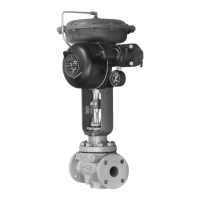Instruction Manual
D200108X012
546 Transducer
March 2015
5
Installation
WARNING
Avoid personal injury from sudden release of process pressure. Before mounting the controller:
D Always wear protective clothing, gloves, and eyewear when performing any installation operations to avoid personal
injury.
D Check with your process or safety engineer for any additional measures that must be taken to protect against process
media.
D If installing into an existing application, also refer to the WARNING at the beginning of the Maintenance section in this
instruction manual.
Mounting
When a 546 transducer is ordered as part of a control valve assembly, the factory mounts the transducer on the
actuator and connects the necessary tubing, then adjusts the transducer as specified on the order.
Transducers also can be ordered separately for mounting on a control valve assembly already in service. The
transducer may be ordered with or without mounting parts. Mounting parts include the appropriate bracket and bolts
for attaching the unit to an actuator boss (with tapped holes) or for attaching it to the diaphragm casing. If preferred,
mounting parts are available for mounting the transducer on a 51 mm (2 inch) diameter pipestand, a flat surface, or a
bulkhead.
Tubing is not included if the transducer is not factory mounted. Use 9.5 mm (3/8‐inch) outside diameter tubing for all
supply and output connections. Tubing length between the transducer output and the final control element should be
as short as possible to minimize its effect on control loop stability.
Pressure Connections
WARNING
Severe personal injury or property damage may occur if the instrument air supply is not clean, dry and oil‐free. While use
and regular maintenance of a filter that removes particles larger than 40 micrometers in diameter will suffice in most
applications, check with an Emerson Process Management field office and industry instrument air quality standards for use
with corrosive air or if you are unsure about the proper amount or method of air filtration or filter maintenance.
Note
The supply source must be clean, dry, oil‐free, non‐corrosive air at an unfailing pressure at least 0.3 bar (5 psig) higher than the
upper limit of the transducer output pressure range. This means that for an output pressure range of 0.2 to 1.0 bar (3 to 15 psig)
the supply pressure should be at least 1.4 bar (20 psig); for a 0.4 to 2.0 bar (6 to 30 psig) range, the supply pressure should be at
least 2.4 bar (35 psig). The supply pressure to the filter regulator should not be more than 17.3 bar (250 psig) at a maximum
temperature of 66_C (150_F).

